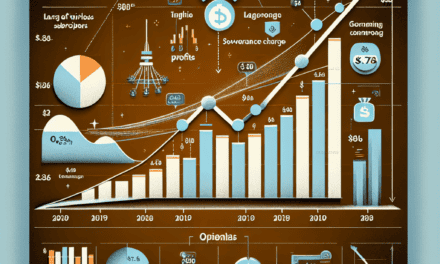“Unlock Decade-High Yields: Invest in Top Dividend Stocks After a 33% and 39% Drop!”
Introduction
Investors seeking reliable income streams often turn to dividend stocks, especially those with yields at decade-highs following significant price declines. Two such stocks have recently caught the attention of savvy investors, offering compelling opportunities for both income and potential capital appreciation. These stocks have experienced notable drops of 33% and 39%, respectively, positioning them as attractive buys in the current market environment. Despite these declines, their fundamentals remain strong, and their commitment to returning value to shareholders through dividends makes them standout choices for those looking to bolster their portfolios with high-yield investments.
Analyzing the Recent Performance of Top Dividend Stocks with Decade-High Yields
In the ever-evolving landscape of stock markets, dividend stocks have long been a cornerstone for investors seeking a blend of income and growth. Recently, two prominent dividend stocks have caught the attention of market analysts and investors alike, as their yields have surged to decade-high levels following significant price declines of 33% and 39%, respectively. This development presents a compelling opportunity for those looking to capitalize on high-yield investments while potentially benefiting from future price recoveries.
To begin with, the first stock under consideration has experienced a 33% drop in its market value, a decline that can be attributed to a confluence of macroeconomic factors and sector-specific challenges. Despite this downturn, the company’s fundamentals remain robust, underscored by its consistent revenue streams and a strong balance sheet. The recent price drop has consequently elevated its dividend yield to levels not seen in over ten years, making it an attractive proposition for income-focused investors. Moreover, the company’s management has demonstrated a commitment to maintaining and even potentially increasing dividend payouts, reflecting confidence in its long-term financial health.
Transitioning to the second stock, which has seen an even steeper decline of 39%, the narrative is somewhat similar. This company operates in a sector that has faced headwinds due to regulatory changes and shifting consumer preferences. However, it has a well-established market presence and a diversified portfolio of products and services that provide a buffer against sector volatility. The significant drop in its share price has pushed its dividend yield to a decade-high, offering a lucrative opportunity for investors seeking stable income. Importantly, the company has a history of prudent financial management, with a focus on optimizing operational efficiencies and cost controls, which bodes well for its ability to sustain dividend payments.
In light of these developments, it is crucial for potential investors to conduct thorough due diligence. While high dividend yields are enticing, they can sometimes signal underlying issues within a company. However, in the cases of these two stocks, the elevated yields appear to be more a function of market overreaction rather than fundamental weaknesses. This presents a unique window for investors to acquire shares at a discount while locking in attractive yields.
Furthermore, the broader economic context should not be overlooked. With interest rates remaining relatively low, dividend stocks continue to offer a compelling alternative to traditional fixed-income investments. The potential for capital appreciation, coupled with regular income from dividends, enhances the overall return profile of these investments. As such, these two stocks, with their decade-high yields, represent a strategic addition to a diversified investment portfolio.
In conclusion, the recent price declines of these two top dividend stocks have created an opportunity for investors to secure high yields at a time when income-generating investments are in high demand. While the market conditions that led to these declines are complex, the underlying strength and resilience of these companies provide a solid foundation for future growth. As always, investors should remain vigilant and consider their individual risk tolerance and investment objectives when making decisions. Nonetheless, the potential rewards of investing in these high-yield dividend stocks are significant, making them worthy of consideration for those seeking to enhance their income streams and capitalize on market inefficiencies.
Understanding the Market Dynamics Behind the 33% and 39% Drop in Dividend Stocks
In the ever-evolving landscape of financial markets, dividend stocks have long been a cornerstone for investors seeking a blend of income and growth. However, recent market dynamics have led to significant price declines in some of these traditionally stable investments. Specifically, two top dividend stocks have experienced notable drops of 33% and 39%, respectively, presenting a unique opportunity for discerning investors. Understanding the factors behind these declines is crucial for making informed investment decisions.
To begin with, the broader market environment has been characterized by heightened volatility and uncertainty. Macroeconomic factors, such as rising interest rates and inflationary pressures, have exerted downward pressure on stock prices across various sectors. As central banks around the world tighten monetary policy to combat inflation, the cost of borrowing increases, which can negatively impact companies with high levels of debt. This, in turn, affects their profitability and, by extension, their stock prices. Dividend stocks, often perceived as safe havens, are not immune to these broader economic forces.
Moreover, sector-specific challenges have also played a role in the decline of these dividend stocks. For instance, companies in the energy sector have faced fluctuating commodity prices, regulatory changes, and geopolitical tensions, all of which contribute to market instability. Similarly, financial institutions, another common source of dividend income, have been navigating a complex landscape of regulatory scrutiny and technological disruption. These sector-specific headwinds can lead to investor apprehension, resulting in sell-offs and subsequent price drops.
Despite these challenges, the current situation presents a compelling opportunity for investors. The significant price declines have pushed the dividend yields of these stocks to decade-high levels, making them attractive for income-focused investors. A higher yield indicates that investors can receive a greater return on their investment relative to the stock’s price, enhancing the appeal of these stocks in a low-yield environment. Furthermore, the underlying fundamentals of these companies remain strong, suggesting that the recent price declines may be more reflective of market sentiment than intrinsic value.
In addition to attractive yields, these dividend stocks offer potential for capital appreciation. As market conditions stabilize and investor confidence returns, there is a likelihood that the stock prices will recover, providing capital gains alongside dividend income. This dual potential for income and growth makes these stocks particularly appealing for long-term investors seeking to build wealth over time.
It is also important to consider the role of diversification in mitigating risk. By incorporating dividend stocks from different sectors into a diversified portfolio, investors can reduce their exposure to sector-specific risks while still benefiting from the income and growth potential these stocks offer. This strategy can help balance the risks associated with individual stock volatility and broader market fluctuations.
In conclusion, while the recent 33% and 39% drops in these top dividend stocks may initially appear concerning, they also present a unique opportunity for investors. By understanding the market dynamics behind these declines and recognizing the potential for high yields and capital appreciation, investors can make informed decisions that align with their financial goals. As always, thorough research and a long-term perspective are essential when navigating the complexities of the stock market.
How to Evaluate Dividend Stocks for Long-Term Investment
When considering dividend stocks for long-term investment, it is crucial to evaluate them based on several key factors that can influence their performance and sustainability. With yields at decade-highs following significant drops of 33% and 39%, two top dividend stocks have emerged as attractive options for investors seeking stable income and potential capital appreciation. To make informed decisions, investors should focus on a company’s financial health, dividend history, payout ratio, and growth prospects.
First and foremost, assessing a company’s financial health is essential. A strong balance sheet with manageable debt levels and robust cash flow is indicative of a company’s ability to sustain and potentially increase dividend payments over time. Investors should examine financial statements to ensure that the company generates sufficient free cash flow to cover its dividend obligations. This financial stability is particularly important in volatile market conditions, where companies with weaker financial positions may be forced to cut or suspend dividends.
In addition to financial health, a company’s dividend history provides valuable insights into its commitment to returning value to shareholders. Companies with a long track record of paying and increasing dividends are often more reliable, as they have demonstrated resilience through various economic cycles. A consistent dividend history suggests that the company prioritizes shareholder returns and is likely to continue doing so in the future. Therefore, investors should look for companies with a history of stable or growing dividends over several years.
Another critical factor to consider is the payout ratio, which measures the proportion of earnings paid out as dividends. A lower payout ratio indicates that a company retains a significant portion of its earnings for reinvestment or to cushion against future downturns. Ideally, investors should seek companies with payout ratios below 60%, as this suggests a sustainable dividend policy. However, it is important to consider the industry context, as some sectors, such as utilities, traditionally have higher payout ratios due to their stable cash flows.
Furthermore, evaluating a company’s growth prospects is vital for long-term dividend investors. Companies with strong growth potential are more likely to increase their dividends over time, providing investors with a rising income stream. Factors such as market position, competitive advantages, and industry trends can influence a company’s growth trajectory. Investors should look for companies with a clear strategy for expansion, whether through organic growth, acquisitions, or innovation.
In light of these considerations, the two dividend stocks with yields at decade-highs present compelling opportunities. Despite their recent price declines, these companies exhibit strong financial health, a history of reliable dividend payments, and promising growth prospects. By focusing on these attributes, investors can identify dividend stocks that not only offer attractive yields but also have the potential for long-term capital appreciation.
In conclusion, evaluating dividend stocks for long-term investment requires a comprehensive analysis of financial health, dividend history, payout ratios, and growth prospects. By carefully considering these factors, investors can identify stocks that provide a stable and growing income stream, even in challenging market conditions. As yields reach decade-highs, the two highlighted dividend stocks stand out as promising options for those seeking to enhance their portfolios with reliable income and potential growth.
The Benefits of Investing in High-Yield Dividend Stocks During Market Volatility

Investing in high-yield dividend stocks during periods of market volatility can offer a strategic advantage for investors seeking both income and potential capital appreciation. As markets fluctuate, these stocks provide a steady income stream, which can be particularly appealing when other investment avenues appear uncertain. Currently, two top dividend stocks have caught the attention of savvy investors due to their yields reaching decade-high levels following significant price drops of 33% and 39%, respectively. This scenario presents a unique opportunity to capitalize on the benefits of high-yield dividend stocks.
Firstly, high-yield dividend stocks can serve as a buffer against market volatility. When stock prices decline, dividend yields often increase, assuming the dividend payout remains stable. This inverse relationship can be advantageous for investors, as it allows them to acquire shares at a lower price while benefiting from a higher yield. In the current market environment, where these two stocks have experienced substantial price declines, their yields have become particularly attractive. This not only enhances the income potential for investors but also provides a cushion against further market downturns.
Moreover, investing in high-yield dividend stocks can contribute to portfolio diversification. During volatile periods, different asset classes and sectors may react differently to market conditions. By incorporating dividend-paying stocks into a portfolio, investors can achieve a more balanced asset allocation. This diversification can mitigate risk and reduce the overall impact of market fluctuations on an investor’s portfolio. The two stocks in question, with their decade-high yields, offer an opportunity to diversify into sectors that may be less correlated with broader market movements, thereby enhancing the stability of an investment portfolio.
In addition to providing income and diversification, high-yield dividend stocks can also offer the potential for capital appreciation. While the primary focus of dividend investing is often the income generated, the underlying stock prices can also appreciate over time. This is particularly true for companies with strong fundamentals and a history of consistent dividend payments. As these companies recover from their recent price declines, there is potential for their stock prices to rebound, offering investors the dual benefit of income and capital gains. The current high yields of these two stocks suggest that the market may have undervalued them, presenting an opportunity for investors to capitalize on future price appreciation.
Furthermore, high-yield dividend stocks can provide a hedge against inflation. As inflation erodes the purchasing power of money, the income generated from dividends can help offset this effect. Companies that consistently pay and increase dividends often have strong cash flows and resilient business models, enabling them to maintain their payouts even in challenging economic conditions. By investing in these stocks, investors can protect their portfolios from the adverse effects of inflation while enjoying a reliable income stream.
In conclusion, the benefits of investing in high-yield dividend stocks during market volatility are manifold. The current market conditions, characterized by significant price drops in two top dividend stocks, present a compelling opportunity for investors to enhance their portfolios. By providing a steady income stream, offering diversification, and presenting potential for capital appreciation, these stocks can serve as a valuable component of an investment strategy. As investors navigate the complexities of market volatility, high-yield dividend stocks stand out as a prudent choice for those seeking stability and growth.
Comparing Dividend Yields: Why These Two Stocks Stand Out
In the ever-evolving landscape of investment opportunities, dividend stocks have long been a cornerstone for investors seeking both income and stability. Recently, two particular stocks have emerged as compelling options, boasting dividend yields at decade-highs following significant price declines of 33% and 39%, respectively. These stocks not only offer attractive yields but also present a unique opportunity for investors to capitalize on potential recovery and long-term growth.
To begin with, the first stock in question has experienced a 33% drop in its market value, a decline that has paradoxically enhanced its appeal to dividend-focused investors. This decrease in price has resulted in a dividend yield that is significantly higher than its historical average, making it an attractive option for those seeking steady income. The company, a stalwart in its industry, has demonstrated resilience through various economic cycles, maintaining a robust balance sheet and a commitment to returning value to shareholders. Its ability to generate consistent cash flow, even in challenging times, underscores its potential as a reliable income-generating asset.
Moreover, the second stock, which has seen a 39% decline, presents a similarly enticing opportunity. This company, known for its innovative approach and strong market presence, has also seen its dividend yield rise to levels not seen in over a decade. Despite the recent downturn, the company remains fundamentally strong, with a strategic plan focused on long-term growth and shareholder returns. Its commitment to innovation and market expansion positions it well for future recovery, making it a compelling choice for investors looking to benefit from both high yields and potential capital appreciation.
Transitioning to a broader perspective, it is essential to consider the factors contributing to these stocks’ current valuations. Market volatility, driven by macroeconomic uncertainties and sector-specific challenges, has played a significant role in the recent price declines. However, these temporary setbacks have created an opportunity for discerning investors to acquire shares at attractive valuations. By focusing on companies with strong fundamentals and a proven track record of dividend payments, investors can mitigate risks while enhancing their portfolio’s income potential.
Furthermore, the current economic environment, characterized by low interest rates and inflationary pressures, underscores the importance of dividend stocks as a source of reliable income. With traditional fixed-income investments offering limited returns, dividend stocks with high yields provide an appealing alternative for income-seeking investors. The ability to generate income through dividends, coupled with the potential for capital gains as market conditions improve, makes these stocks particularly attractive in today’s market.
In conclusion, the two stocks highlighted here stand out not only for their decade-high dividend yields but also for their strong fundamentals and potential for recovery. While the recent price declines may have raised concerns, they also present a unique opportunity for investors to acquire high-quality dividend stocks at attractive valuations. By carefully evaluating these opportunities and considering the broader economic context, investors can make informed decisions that align with their income and growth objectives. As always, it is crucial to conduct thorough research and consider individual risk tolerance before making any investment decisions.
Strategies for Maximizing Returns with High-Yield Dividend Stocks
In the ever-evolving landscape of investment opportunities, high-yield dividend stocks have emerged as a compelling option for investors seeking to maximize returns. With the recent market fluctuations, certain dividend stocks have experienced significant price drops, presenting a unique opportunity for savvy investors. Notably, two top dividend stocks have seen their yields reach decade-high levels following declines of 33% and 39%, respectively. This scenario offers a strategic entry point for those looking to capitalize on the potential for both income and capital appreciation.
To begin with, it is essential to understand the intrinsic value of dividend stocks in an investment portfolio. Dividend stocks provide a dual benefit: they offer regular income through dividend payments and the potential for capital gains as the stock price appreciates over time. This combination makes them particularly attractive in volatile markets, where the stability of dividend income can offset the unpredictability of stock prices. Moreover, companies that consistently pay dividends often exhibit strong fundamentals, as they typically generate sufficient cash flow to support these payments.
In light of recent market corrections, the yields on some dividend stocks have surged to levels not seen in a decade. This increase in yield is primarily due to the inverse relationship between stock prices and dividend yields; as stock prices fall, yields rise, assuming the dividend remains constant. Consequently, investors can now acquire shares of these companies at a lower cost while benefiting from higher yields. This scenario is particularly advantageous for long-term investors who can weather short-term market volatility in pursuit of sustained income and growth.
One of the key strategies for maximizing returns with high-yield dividend stocks is to focus on companies with a strong track record of dividend payments and growth. These companies often operate in stable industries with predictable cash flows, such as utilities, consumer staples, and telecommunications. By selecting stocks with a history of increasing dividends, investors can potentially benefit from a rising income stream over time, which can further enhance total returns.
Additionally, diversification plays a crucial role in managing risk when investing in high-yield dividend stocks. By spreading investments across various sectors and geographies, investors can mitigate the impact of sector-specific downturns and economic fluctuations. This approach not only reduces risk but also increases the likelihood of capturing growth opportunities in different market environments.
Furthermore, it is important to conduct thorough research and due diligence before investing in high-yield dividend stocks. Investors should assess the financial health of the company, including its debt levels, cash flow stability, and payout ratio. A sustainable payout ratio, typically below 60-70%, indicates that the company is not overextending itself to maintain its dividend payments. This analysis helps ensure that the dividend is not only attractive but also sustainable in the long run.
In conclusion, the current market conditions present a unique opportunity for investors to acquire high-yield dividend stocks at attractive valuations. By focusing on companies with strong fundamentals, a history of dividend growth, and a commitment to shareholder returns, investors can strategically position themselves to maximize returns. Through diversification and diligent research, they can navigate the complexities of the market and harness the potential of high-yield dividend stocks to achieve their financial goals. As always, it is advisable to consult with a financial advisor to tailor investment strategies to individual risk tolerance and objectives.
The Role of Dividend Stocks in a Diversified Investment Portfolio
Dividend stocks have long been a cornerstone of diversified investment portfolios, offering investors a reliable stream of income alongside the potential for capital appreciation. In times of market volatility, these stocks can provide a cushion against the unpredictable swings of the broader market. Recently, two top dividend stocks have caught the attention of savvy investors, as their yields have reached decade-high levels following significant price drops of 33% and 39%, respectively. This presents a unique opportunity for those looking to enhance their portfolios with high-yield investments.
The appeal of dividend stocks lies in their ability to generate passive income, which can be particularly attractive in a low-interest-rate environment. By reinvesting dividends, investors can take advantage of compounding returns, thereby increasing their overall wealth over time. Moreover, companies that consistently pay dividends often exhibit strong fundamentals and stable cash flows, making them a relatively safer bet compared to non-dividend-paying stocks. This stability is crucial for investors seeking to mitigate risk while still participating in the equity markets.
Incorporating dividend stocks into a diversified portfolio can also provide a hedge against inflation. As the cost of living rises, the purchasing power of fixed-income investments, such as bonds, may erode. However, dividend-paying companies often have the ability to increase their payouts over time, thereby helping investors maintain their purchasing power. This characteristic makes dividend stocks an attractive option for those looking to preserve their wealth in the face of inflationary pressures.
The recent price declines of the two highlighted dividend stocks have resulted in yields that are now at decade-high levels. This scenario is not uncommon, as market corrections can lead to temporary mispricing of fundamentally sound companies. For investors with a long-term perspective, such opportunities can be particularly rewarding. By purchasing these stocks at a discount, investors can lock in higher yields, which can significantly enhance the income-generating potential of their portfolios.
Furthermore, the companies behind these dividend stocks are likely to have robust business models and a history of weathering economic downturns. This resilience is often reflected in their ability to maintain, or even increase, dividend payouts during challenging times. As a result, investors can have greater confidence in the sustainability of their income streams, even when market conditions are less than favorable.
It is important to note, however, that not all high-yield stocks are created equal. Investors must conduct thorough due diligence to ensure that the underlying companies have the financial strength to support their dividend payments. Factors such as payout ratios, debt levels, and cash flow generation should be carefully evaluated to assess the sustainability of the dividends. By doing so, investors can avoid potential pitfalls and focus on stocks that offer both attractive yields and solid fundamentals.
In conclusion, dividend stocks play a vital role in a diversified investment portfolio by providing a steady income stream, potential for capital appreciation, and a hedge against inflation. The current market environment, characterized by significant price drops in certain high-yield stocks, presents a compelling opportunity for investors to enhance their portfolios. By carefully selecting dividend stocks with strong fundamentals, investors can capitalize on these opportunities and enjoy the benefits of a well-rounded investment strategy.
Q&A
1. **Question:** What are the two top dividend stocks mentioned?
**Answer:** The specific stocks are not provided in the prompt. Please provide the names or context for accurate information.
2. **Question:** What is the yield status of these stocks?
**Answer:** The yields of these stocks are at decade-highs.
3. **Question:** By how much have these stocks dropped?
**Answer:** One stock has dropped by 33%, and the other by 39%.
4. **Question:** Why might these stocks be considered attractive investments now?
**Answer:** They are considered attractive due to their high dividend yields and potential for recovery after significant price drops.
5. **Question:** What is a dividend yield?
**Answer:** A dividend yield is a financial ratio that shows how much a company pays out in dividends each year relative to its stock price.
6. **Question:** What factors could contribute to a stock’s price drop?
**Answer:** Factors could include market volatility, company-specific issues, economic downturns, or changes in industry conditions.
7. **Question:** What should investors consider when buying high-yield dividend stocks?
**Answer:** Investors should consider the sustainability of the dividend, the company’s financial health, growth prospects, and overall market conditions.
Conclusion
Two top dividend stocks currently offering yields at decade-highs after significant price drops are AT&T Inc. (T) and 3M Company (MMM). AT&T, having experienced a 33% decline, presents an attractive opportunity with its robust dividend yield, supported by its stable cash flow from telecommunications services. Despite challenges in the media sector, AT&T’s core business remains strong, making it a reliable income source. Similarly, 3M, with a 39% drop, offers a compelling dividend yield, backed by its diversified industrial operations and commitment to innovation. While facing legal and regulatory hurdles, 3M’s long-term growth prospects and consistent dividend history make it a solid choice for income-focused investors. Both stocks, with their high yields and potential for recovery, provide appealing options for those seeking to enhance their dividend portfolios.





